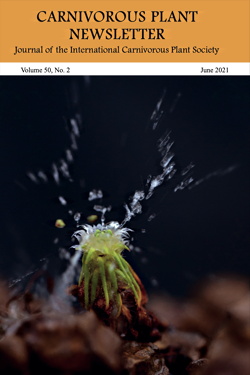International Carnivorous Plant Society
Carnivorous Plant Newsletter Archive
On Dipsacus and Drosera: Francis Darwin's favorite carnivores
John R. Schaefer
Carniv. Pl. Newslett. 50(2):73-80
Published 11 May 2021
https://doi.org/10.55360/cpn502.js457
Abstract
In autumn of 1875, Francis Darwin was busy researching aggregation in the tentacles of Drosera rotundifolia. This phenomenon occurs when colored particles within either 'protoplasm' or the fluid in the cell vacuole (the cell sap) cluster together. Charles Darwin had theorized in the book Insectivorous Plants that these aggregated cellular masses consisted of living protoplasm. Inspired by his investigation of Drosera, Francis set out to examine the cup-like receptacles formed by the leaves of Dipsacus fullonum (synonym D. sylvestris), commonly known as fuller's teasel. Francis went on to suggest that the common teasel might be a carnivorous plant, acquiring nutrients from decaying insects drowned in its water-holding basins. Since then, other biologists have evaluated these claims with little experimental success. This paper provides a historical overview of Darwin's experiments with Dipsacus based on extant correspondence, discussing his results in the context of later studies that examine this unusual adaptation.
Keywords: Dipsacus, Drosera, Francis Darwin, carnivory, insectivorous plants, common teasel
Article Citation
John R. Schaefer. 2021. On Dipsacus and Drosera: Francis Darwin's favorite carnivores. Carniv. Pl. Newslett. 50(2):73-80. https://doi.org/10.55360/cpn502.js457
Page views: 1416
©2025 International Carnivorous Plant Society
www.carnivorousplants.org
This page is maintained by John Brittnacher.
Please contact us at our membership website, icps.clubexpress.com.
Privacy: The Carnivorous Plant Newsletter Archive website does not track users.

